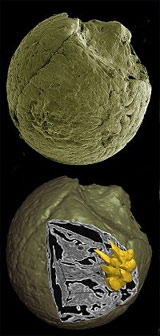The first hologram of the dawn of life
Scientists have obtained the first 3D images of primitive organisms thanks to a new technique that allows "virtual dissection " of fossils dating to half a billion years.
 Embryos of penis penis (Markuelia), overall (upper) and partial embryos have developed into the digestive tract (bottom). (Photo: Reuters) Among them, embryonic images of ancient penis worms (Markuelia) are found in China and Siberia, living in the Cambrian period.
Embryos of penis penis (Markuelia), overall (upper) and partial embryos have developed into the digestive tract (bottom). (Photo: Reuters) Among them, embryonic images of ancient penis worms (Markuelia) are found in China and Siberia, living in the Cambrian period.
This new imaging technique reveals all the details that traditional methods cannot bring, from the first cell division phase to the stage just before the animal hatches.
Researchers at the University of Bristol, UK, say their technique helps push the boundaries of science back into the past in the same way that microelectronic scanning techniques did half a century ago."We are looking back at the dawn of life," said Dr. Phil Donoghue, the leader.
"Because of their small size and fragile conservation capabilities, the embryos have become the rarest fossils. But these fossils are more accurate because they contain information about evolutionary change. happened in embryos over 500 million years ago, " said Donoghue.
In the past, if we wanted to study fossil embryos, one had to observe them from the outside, or cut the embryos into thin slices - the action would naturally destroy them.
But the new method, also known as synchroton-radiation x-ray tomographic microscopy (or SRXTM), helps these tiny specimens remain intact, while creating detailed graphics of the structure of them.
The team used a large particle accelerator in Switzerland to capture the fossils. Then they put the information into a computer to produce a three-dimensional image of the internal structure at an extremely meticulous level.
"It's similar to a medical CT scanner, but the resolution is 2,000 to 3,000 times. We can see details as small as a thousandth of a millimeter," says Donoghue.
"We can observe any fossil and any part, inside and out, without touching it and then dissecting it in virtual form as you like."
The team said their discovery could turn back the evolutionary history of arthropods like insects and spiders.
T. An
- Breakthrough opens the hologram era
- Admire the beauty of dawn on every part of the country
- NASA spacecraft runs out of fuel after a 7 billion km journey
- Learn about sunrise and sunset
- Not sunset, dawn is always red, everything has a reason
- Explain the mystery of the halo at dawn
- Video: The US develops technology for remote interaction emulation
- The NASA spacecraft first explored asteroids
- Track tumor growth through 3D technology
- Northern dawn
- Discover life in a place where there is no summer
- NASA explores the abandoned planet Vesta
 'Fine laughs' - Scary and painful torture in ancient times
'Fine laughs' - Scary and painful torture in ancient times The sequence of numbers 142857 of the Egyptian pyramids is known as the strangest number in the world - Why?
The sequence of numbers 142857 of the Egyptian pyramids is known as the strangest number in the world - Why? History of the iron
History of the iron What is alum?
What is alum?